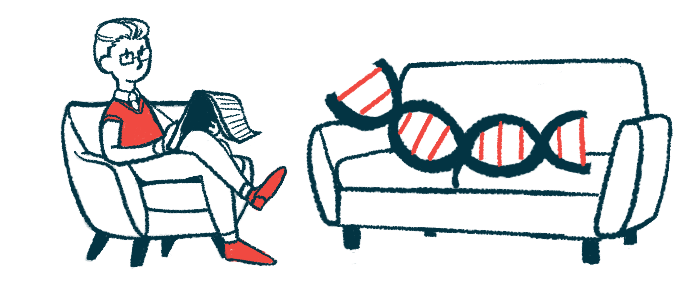Angelman gene therapy is made for preclinical-clinical translation
GTX-102 designed specifically for use in patients, animal models
Written by |

Because antisense oligonucleotide (ASO) therapies target specific genetic sequences, differences across mammals make it challenging to translate potential Angelman ASO-based therapies from preclinical models to the clinic.
GTX-102, an investigational ASO therapy for Angelman syndrome, was specifically designed to be effective in patients and relevant animal models, however.
As described in “An ASO therapy for Angelman syndrome that targets an evolutionarily conserved region at the start of the UBE3A-AS transcript,” GTX-102 addresses this problem by targeting a genetic region associated with Angelman, which is similar between humans and nonhuman primates, a common animal model. The study was published in Science Translational Medicine.
Initially developed by Scott Dindot, PhD, at Texas A&M University’s School of Veterinary Medicine and Biomedical Sciences, GTX-102 is being evaluated in the Phase 1/2 KIK-AS clinical trial (NCT04259281).
Sponsored by Ultragenyx Pharmaceutical, where Dindot is an executive director, the trial is expected to enroll up to 83 children with Angelman, ages 4-17, at in the U.K., the U.S., Australia, and Canada.
Last year, interim data for 11 treated patients showed GTX-102 was well tolerated and improved behavior, motor function, communication, and sleep.
“We used a novel approach to designing the ASOs, targeting a very specific part of a gene rather than just giving a drug to treat a symptom,” Dindot said in a university news release. “In theory, this treatment goes after the heart of the condition.”
Designing a treatment for animal models, people
The UBE3A gene encodes for ubiquitin protein ligase E3A (UBE3A), an enzyme that tags unwanted or damaged proteins to be broken down as part of the cell’s recycling process.
Both gene copies, inherited from each parent, are active in most cells, but only the mother’s copy is active in specific regions of the brain. Here, the father’s gene is silenced by another gene called the UBE3A antisense (UBE3A-AS) transcript.
Because the paternal gene is inactive, defects in the maternal UBE3A gene impair UBE3A enzyme activity and cellular recycling. Such defects disrupt normal nerve cell function and result in Angelman symptoms, including seizures, developmental and speech delays, and movement disorders.
Reactivating the paternal UBE3A gene in the brain has been extensively investigated as a therapeutic approach for Angelman syndrome. ASOs — small lab-made molecules comprising DNA and RNA — designed to suppress UBE3A-AS and activate the paternal gene, have led to cognitive benefits in Angelman mouse models.
Because of significant genetic differences between humans and mice, however, it’s unclear if these ASOs will translate from animal models into clinical practice. Identifying a target region within UBE3A-AS that’s the same, or conserved, across mammals, would be ideal.
Dindot and his team compared the genetic sequence of human UBE3A-AS to those of other mammals to find unique regions that had regulatory potential and were conserved between humans and a suitable animal model.
They discovered a previously unknown regulatory region at the start of human UBE3A-AS that was conserved, potentially representing the ancestral origin of the gene in mammals.
“Parts of this region have remained unchanged for over 30 million years,” Dindot said. “The UBE3A-AS transcript is an incredibly complex gene. What it is and how it is regulated has been debated for years.”
The researchers designed ASOs to target this conserved region, with the goal of suppressing UBE3A-AS’s activity and reactivating paternal UBE3A in both animal models and humans.
Using nerve cells from a person with Angelman, they successfully targeted this region, effectively repressing UBE3A-AS and activating the paternal UBE3A gene.
Infusing the ASO into the spinal canal (intrathecal injection) in macaque monkeys, a common nonhuman primate model, also reduced UBE3A-AS and increased paternal gene activity in several regions of the brain and spinal cord.
“These findings support the advancement of this investigational molecular therapy for Angelman syndrome into clinical development,” the researchers wrote.
Dindot initially collaborated with GeneTx Biotherapeutics, then Ultragenyx, which together launched KIK-AS. Last year, Ultragenyx acquired GeneTx to continue GTX-102’s development.
In 2020, early KIK-AS results supported GTX-102’s effectiveness, but higher doses were associated with leg weakness in five children. The study resumed in 2021 after GeneTx and Ultragenyx paused the trial to amend the dosing and administration protocols. Based on the promising results from the 11 patients in the Phase 1/2 study, an amendment was made to allow higher monthly doses.
“Moving forward, our research and findings not only offer promise for [Angelman syndrome], but also provide a path forward for developing ASO therapies for other genetic disorders,” Dindot said.






